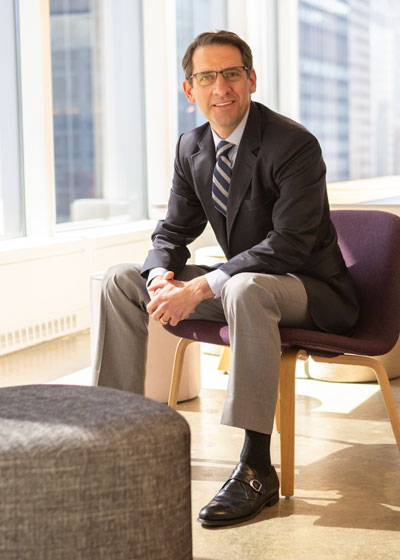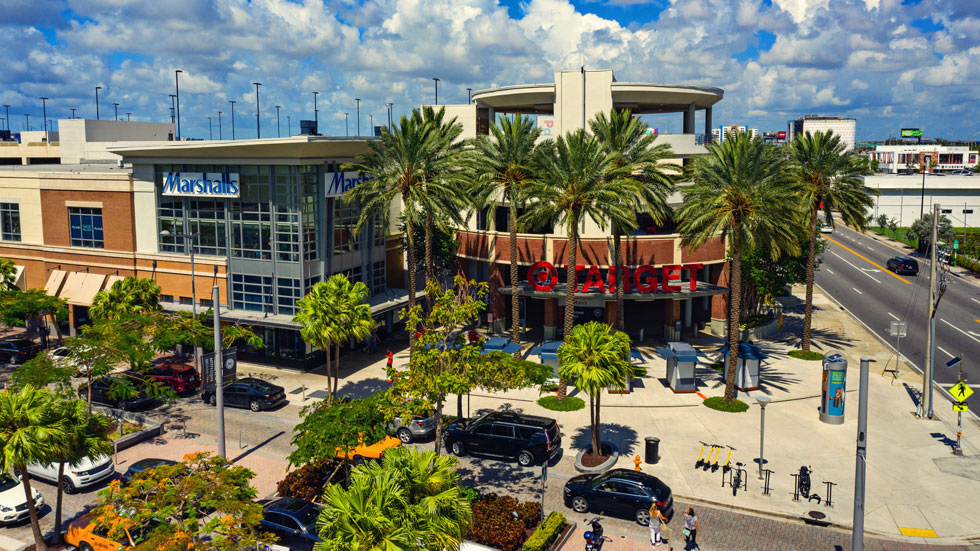SITE Centers CEO David Lukes says the pandemic showed how its open-air shopping centers have become a natural connection to neighborhood customers.
With a challenging year now behind it, SITE Centers Corp. (NYSE: SITC) is looking ahead to the prospect of pandemic-induced societal shifts and data-driven leasing strategies fueling strong cash flow growth in the years ahead.
“The early COVID months certainly put pressure on our business, but a durable bounce-back has already started and SITE Centers is in the early stages of a growth cycle,” says David Lukes, SITE Centers president and CEO. Lukes is also a member of Nareit’s 2021 Advisory Board of Governors.
Lukes has an extensive resume in the retail real estate sector, having served as: president and CEO of Equity One, Inc. prior to its merger with Regency Centers Corp. (Nasdaq: REG); CEO at Seritage Realty Trust; and, COO at Kimco Realty Corp. (NYSE: KIM).
SITE Centers—known as DDR Corp. until October 2018—owns about 140 open-air shopping centers in suburban markets from coast to coast. The company’s focus is on centers in high-income household areas; it owns 78 properties in locations with an average household income of $106,000—a group more likely to have jobs allowing the flexibility to work from home.
“Open air shopping centers are clearly a post-COVID winner and our company is in a great position to step into the growth tailwind,” Lukes says.
While the Beachwood, Ohio–based company did see some disruption during the crisis, more than 80% of the portfolio is anchored by an essential tenant, and many tenants, such as theaters and fitness facilities, are at least partially reopening.
Working from home is driving higher and more consistent traffic, while the urban-to-suburban shift is also boosting the suburban population and housing activity. Retailers, meanwhile, continue launching new anchor concepts and in the fourth quarter total leasing volume was the highest level since the third quarter of 2018.
“Who knew convenience was so convenient? Post-pandemic trends are already favoring open-air shopping centers as the most reliable bridge to suburban customers,” Lukes says.
“More people in the suburbs and more workers with flexible work-from-home policies. It’s hard to imagine a better backdrop for open-air shopping centers. Occupancy and rent growth, here we come,” he adds.
REIT magazine talked to Lukes about what he sees for the future of SITE Centers and how the pandemic is reshaping retail.
You have spent the majority of your career in retail real estate. How did you get your start in the industry?
I was lucky enough to stumble into the shopping center industry a little over 20 years ago. I opened a small field office on the second floor of a local property and the door to my office entrance was right between the pizza guy and the hair salon.
The first thing I learned about retail was that it was a very personal business. When you work at the local shopping center, you quickly realize that you’re going to run into just about everyone in town—small business owners, local politicians, families, the local police and fire departments, and daytime office workers.
Most American suburbs that were built after World War II don’t have a traditional main street, so the local shopping center is one of the few places where people from the community cross paths on a weekly basis. This puts enormous responsibility on a retail landlord as tenant selection is a critical part of long-term real estate value creation. Each shopping center develops its own personality and culture depending on which tenants occupy space at the center. This is probably the most unique aspect of our business.
How would you describe the state of the retail industry today?
The societal shifts that are currently happening as a result of the pandemic are having the most dramatic effects on open-air shopping centers that I’ve seen in my career. Our tenants do best when they serve the convenience needs of customers and those customers have adapted quickly over the past year.
Suburban living is highly desirable, and some form of work-from-home appears to be a permanent part of the American economy. These trends are resulting in a large increase in leasing activity for open-air retail properties and we are seeing occupancy and rent growth as a result.
Did you think these societal changes will be permanent for the industry?
It’s hard to overestimate the long-term effects of the work-from-home cultural change we’ve seen in the past year. I’m amazed at how fast our own company adapted to remote work and adopted tools like Microsoft Teams and Zoom. Like many companies, we’ve accepted this change to our corporate culture, and we will likely have one to two days of work from home and three to four days of work from the office as a permanent benefit to our team members.
We are certainly not alone in this decision as recent national surveys show over two-thirds of employers and employees expect some sort of flexible work policies in the future. This is a gigantic benefit to shopping centers. A typical working family has traditionally visited shopping centers over the weekend whereas now they’ll be proximate to our properties another day or two a week.
If you are a convenience-based retail or service tenant, imagine what this permanent work-from-home flexibility means to your potential gross sales. And if you’re a shopping center landlord, imagine what this means to the durability and growth of market rents.
What lessons did you learn from COVID?
Certainly, any executive team is rightfully focused on capital allocation and long-term strategy. But during COVID, I think we all learned the great importance of corporate culture. Many investors are focused on ESG and stakeholder capitalism and I learned some important lessons on why those attributes are important for long-term success.
We learned that we were doing some things right, like empowering managers to make fast decisions, and we learned that we needed to improve on other aspects such as communication and inclusion.
You mentioned remote work technology, are there other IT Initiatives that you see changing your industry?
Remember I said I opened my first office on the second floor of a shopping center? Well, one of my first jobs was to try and understand our customers so I hired a few temporary employees to write down license plate numbers in the parking lot and get zip code data from the DMV so I could get some window into our trade area. It seems a bit silly now, but 20 years ago that’s all we had.
In the past three years, there has been a complete transformation of our understanding of our properties because of the explosion of cell phone geo-location data availability. Today, I can tell you how many customers go to a Starbucks at our property daily, what percentage of those customers also shop at Target on the same day, and even which restaurants draw office workers at lunch versus residents at dinner.
Geo-location data has become much more than an interesting curiosity, it’s become a very important part of leasing strategy. We’re using trade area data and demographics of actual customer visits to match the right tenant with those customers. The more surety a tenant has that their desired customer is visiting our property, the more rent they are willing to pay to have access to those customers. I think the reduction of risk for a tenant due to data availability is going to produce higher rent growth for SITE Centers going-forward.
How is the continued proliferation of e-commerce impacting your business model?
For at least the last 10 years, there’s been a looming dark cloud over brick-and-mortar retail as landlords wondered what the long-term effect of e-commerce would have on physical property operations and values. Like many investors, we gave a lot of thought to defensive moats that we could build around our properties, such as leasing to service providers or retailers with business models that aren’t easily replicated online.
As it turns out, COVID has proved that moats were less important than bridges. We quickly became a natural connection to neighborhood customers as we are quite literally the most convenient method and cost-effective distribution of goods and services to suburban communities and our tenants are recognizing this fact by growing their footprint at our properties. You might be surprised to learn that of the top 10 largest e-commerce retailers in the United States, nine are current tenants of SITE Centers.
What initiative at SITE Centers are you currently most excited about this year?
Ownership of our industry is getting much more sophisticated and institutional. One of the opportunities we see is in sustainability as it relates to improvements in technology. Shopping centers are simple buildings and they have an antiquated system with respect to energy. The tenants generally pay utility companies directly for their power consumption but we, the landlord, install and usually own the rooftop mechanical units.
Energy use and management is highly inefficient in shopping centers and is ripe for disruption. If you consider the impact that Nest style thermostats have had on single-family homes, imagine the possibilities with remote control and monitoring of energy for commercial retail properties. After all, 40% of carbon emissions in the U.S. are from buildings and 90% of the electric load is from heating, cooling, and lighting. We’re implementing remote IoT (Internet of Things) controls at our properties and are projecting a meaningful reduction in carbon output as a result.
What should shareholders expect to see from your company over the next three years?
External growth. Our current leasing activity is so strong that we’ll simply run low on leasable inventory in the next year and the capital we’re spending on leasing today will shift to external investments in acquiring new properties.
The fact is that convenience properties in wealthy suburbs are experiencing a sort of renaissance due to population trends and I expect us to invest into these trends with the data we see on rent growth and customer activity.
Are there any disruptive technologies that will impact shopping centers in the future?
I don’t see changes in the desirability of the suburbs, but I do see changes to the automobile having an interesting impact.
We formed a pilot program three years ago with Waymo, Google’s autonomous vehicle division, to study the possibilities of the technology at one of our large properties in Arizona. The pandemic forced a very fast adoption of both customers and retailers using the store as a successful last-mile fulfillment center and I’d expect an eventual rollout of driverless cars to offer even more opportunities. Convenience centers may actually become even more convenient.

